Planning: Discovering Southeast Asia
Read about our trip to Vietnam, discovering Southeast Asia (Part 1). These are my thoughts and opinions, often just musings. If I offend or annoy, forgive me!!
Our history with Vietnam
My husband was born near Nha Trang, Vietnam, and escaped with his family in 1975 during the fall of Saigon. This is part of the reason Vietnam holds such intrigue for me – what magical place could produce such a wonderful man? The country, like him, is mysterious, exotic, and fascinating. His family (also now my family), turned me on to Vietnamese cuisine, which is fresh, delicious, and complex. A delicate dance of flavors, textures, and temperatures comes together to make something delightful. The powerful women in his family inspire me, and the men are playful and entertaining.
My Uncle fought in the Vietnam War as a Marine. I can never fully understand all the politics that played into the situation (although I try), and am not about to tackle that here! And, for sure, I will never know the pain and sacrifices he and his comrades made. What I do know is that I will always honor and appreciate him and the millions who suffered and fought. I don’t have the words to express just how grateful I am. From a selfish standpoint, without his (and his comrades) sacrifices, I would never have found the love of my life. Who knows where he and that half of my family, would be? Surely they would not enjoy the prosperity and freedom they do today. But this is not about the war, I just felt like this post would not be complete without acknowledging my Uncle.
So, this country has been significant in my life, and the lives of so many people I love. It only made sense for us to visit. We are planning another visit in February, so it made sense for me to write this now, in anticipation of that trip.
The Best Laid Plans…
We had planned to do the classic first-timer’s Vietnam trip, flying into Hanoi and making our way down to Saigon/Ho Chi Minh City. When Formosa, a Taiwanese steel plant, dumped tons of waste into the South China Sea, dead fish washed ashore throughout central Vietnam, and protests were sparked. Fishermen were out of work and tourism tumbled. Read about the incident here.
Because of this, we decided to limit our exploration of Vietnam to the Northern portion, which was less affected by the spill, and tack on some time in Southern Thailand. We knew we would be back and, as I have mentioned, we try to avoid letting FOMO cause us to feel rushed.
Before You Go
We used an all-inclusive outfitter for this trip, Journeysmiths. This wonderful company crafts bespoke, high-end trips all over the world. Back in 2017, we were babes in the travel womb, so we enjoyed a little hand-holding. This company took care of us from our arrival in Hanoi, Vietnam, until our departure from Koh Samui, Thailand. We have used them for three trips- our safari in Botswana, our Trek to Machu Picchu, and this one. Each has gone off without a hitch!
This company is pricey, but it can be worth it to have everything taken care of. On the other hand, it can be fun to explore and figure things out for yourself. There are tons of resources that will help you do this. A few things are necessary to do before you go.
At the time, US citizens visiting Vietnam must have a visa. The requirements and types of visas available for Vietnam change, particularly in the face of COVID-19, so check on this before you go. Check the US Department of State website for current info here, or go directly to the page for the Vietnam Embassy here. At the time of writing, only 30-day, single-entry e-visas are available and must be obtained in advance. Because we are entering Vietnam twice on our next trip, we have to apply for two.
Money and Transportation
When we travel, we typically take $200-300 US. When we arrive at the airport, we pull money out of an ATM to avoid exchange fees. We have the cash as a backup in case no ATMS are available/operational. We usually don’t exchange money, instead using our ATM cards. But my philosophy is ALWAYS have a Plan B. Taxis here are notorious for scams; therefore, rideshare is recommended. You need to download rideshare apps, one of the most popular being GRAB. You can order a car or, if you are more adventurous and want to live like a local, a scooter. There are food delivery services as well. Read about rideshare in Vietnam here.
For information about SIM cards, rideshare, money, etc., check out my friends’ YouTube channel: Chasing the Sun.
Packing
For our long international flights which often have multiple layovers, we try to pack carry-ons only. This saves time at the airport and avoids the potential nightmare of lost luggage. I can pack for a month in Africa in one backpack, but for a weekend visiting family, it takes a suitcase! I keep the clothing monochromatic and comfortable and never travel without febreeze (thanks Sara). It is often possible to do laundry for very cheap, so that can cut your packing in half or by two-thirds.
We are typically pretty active, so I pack lots of yoga pants and running tights. High-tech fabrics tend to be smaller and lighter, and often even have odor control, so I find them worth the investment. Eddie Bauer has several great travel dresses, which tend to be wrinkle-free and modest. Many Asian and African countries are conservative in dress, and it is important to respect cultural norms. Not to mention, to tour many temples, you must cover your knees and shoulders.
Check out my Amazon travel gear list, where you will find some products we enjoy. Our backpacks are by Gregory and have lots of great pockets. I prefer a good backpack to a roller bag, as they are easier to carry up and down stairs and over cobbly streets. Packing cubes are very helpful in preventing a jumbled mess of clothing in your backpack or suitcase.
I always take a journal and try to write in it daily. When I scrapbook, this is great for journaling and remembering the context for pictures. And now, it helps me remember details for you!
Flights: Discovering Southeast Asia
We were able to book Singapore Airlines First Class Suites using points to reach our goal of visiting Vietnam and discovering Southeast Asia. Check out my blog post on How to Book First or Business Class Flights with POINTS. Sometimes the routing can be challenging, but when traveling to Asia, we like to make a gradual transition. Moreover, it is possible to have really fun layovers in cool cities.
So, we flew to New York City, where we spent the night at the Millennium Broadway Hotel near Times Square, and took in the St. Patrick’s Day parade. Then we headed to JFK airport to catch our Singapore Airlines flight to Singapore via Frankfurt. We spent the night in Singapore then caught our flight to Hanoi, Vietnam.
Unfortunately, I don’t remember exactly what we had to eat, but we were able to “book the cook” ahead of time on Singapore Airline’s website. I do remember lobster thermidor and lamb rendang. I enjoy the “book the cook” feature, as planning trips is a huge part of the excitement for me. Oh, and I do enjoy airplane food (weirdo). With that said, this was no normal airplane food. This rivaled food in a nice restaurant.
Singapore Suites
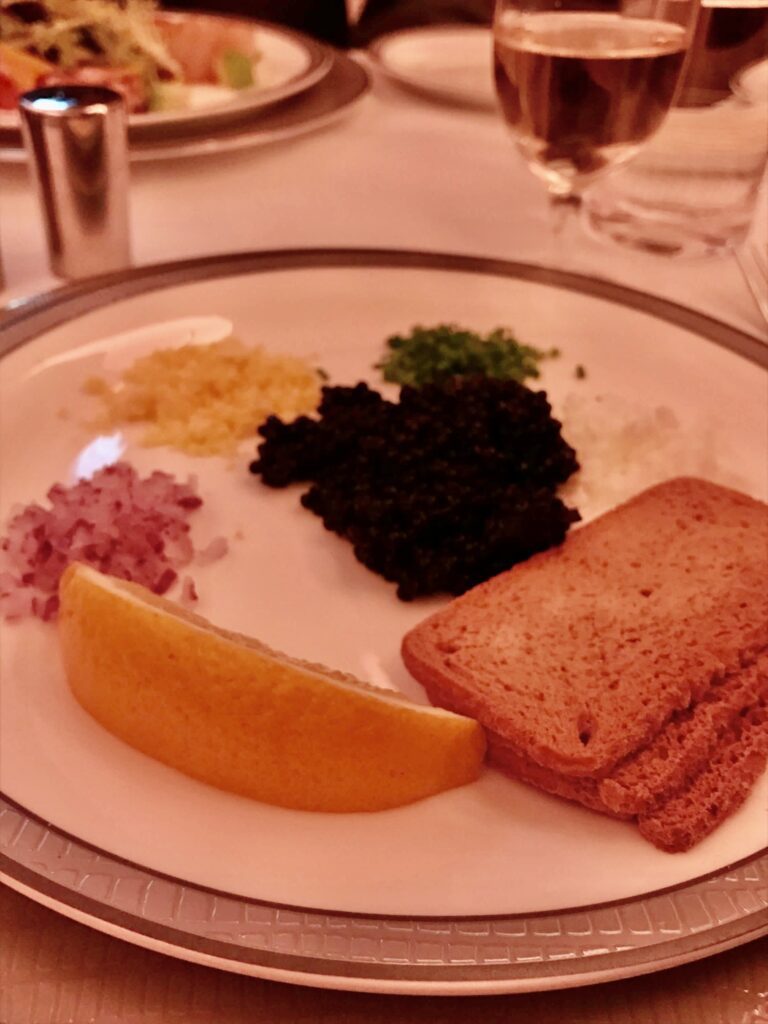
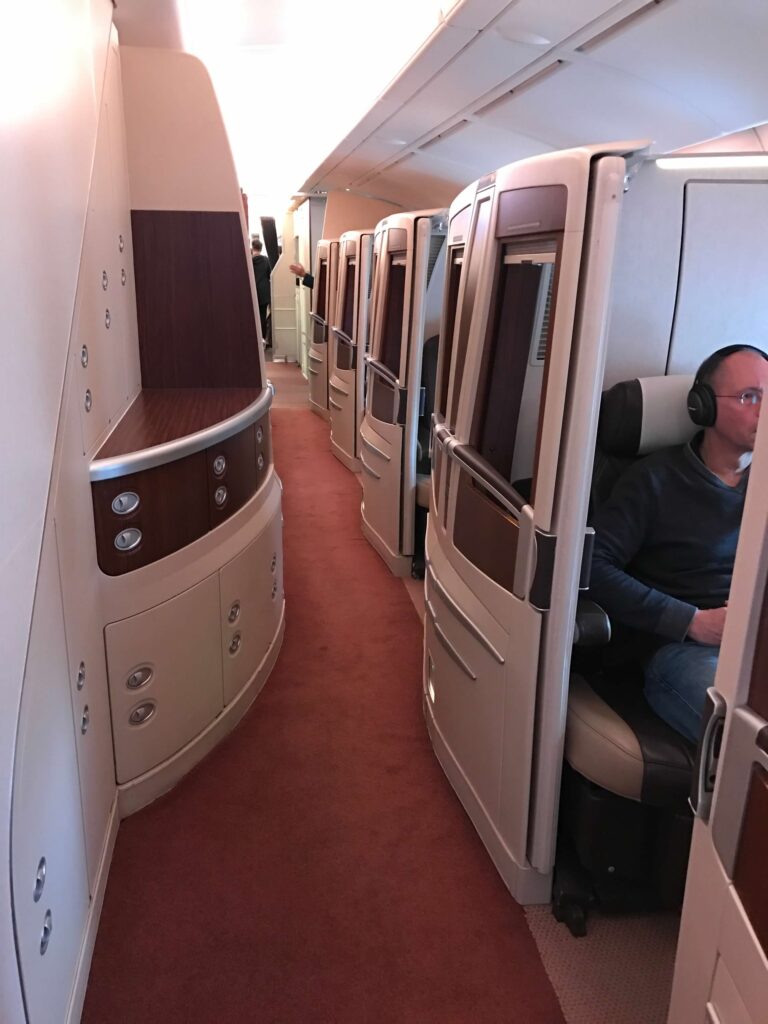
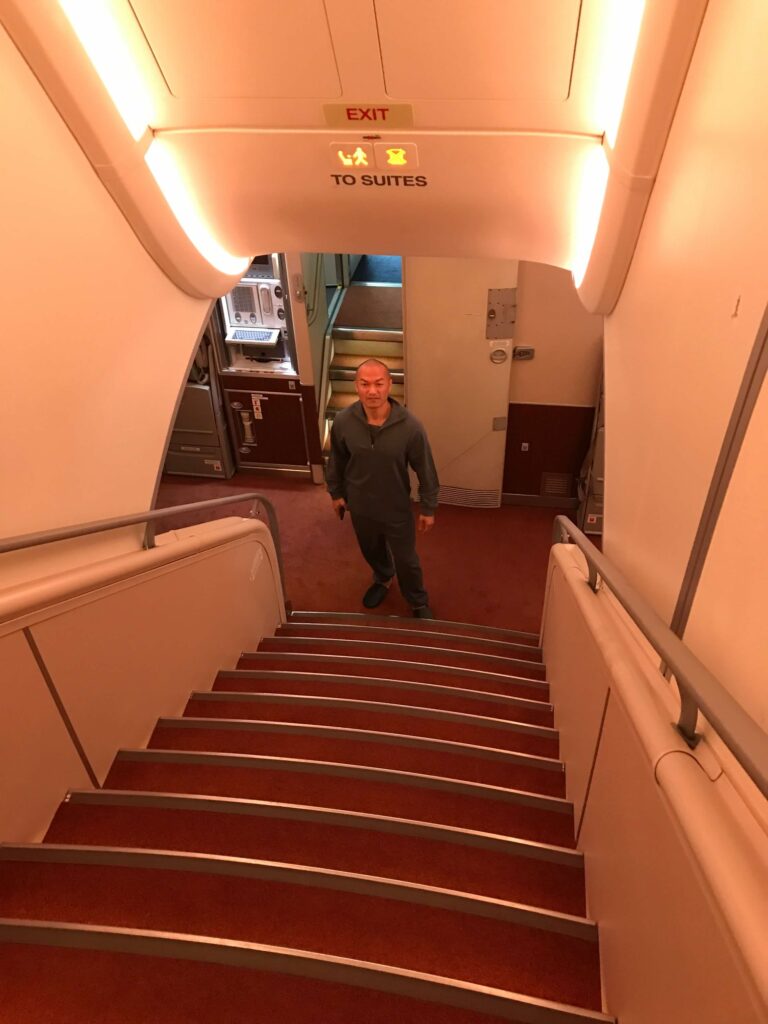
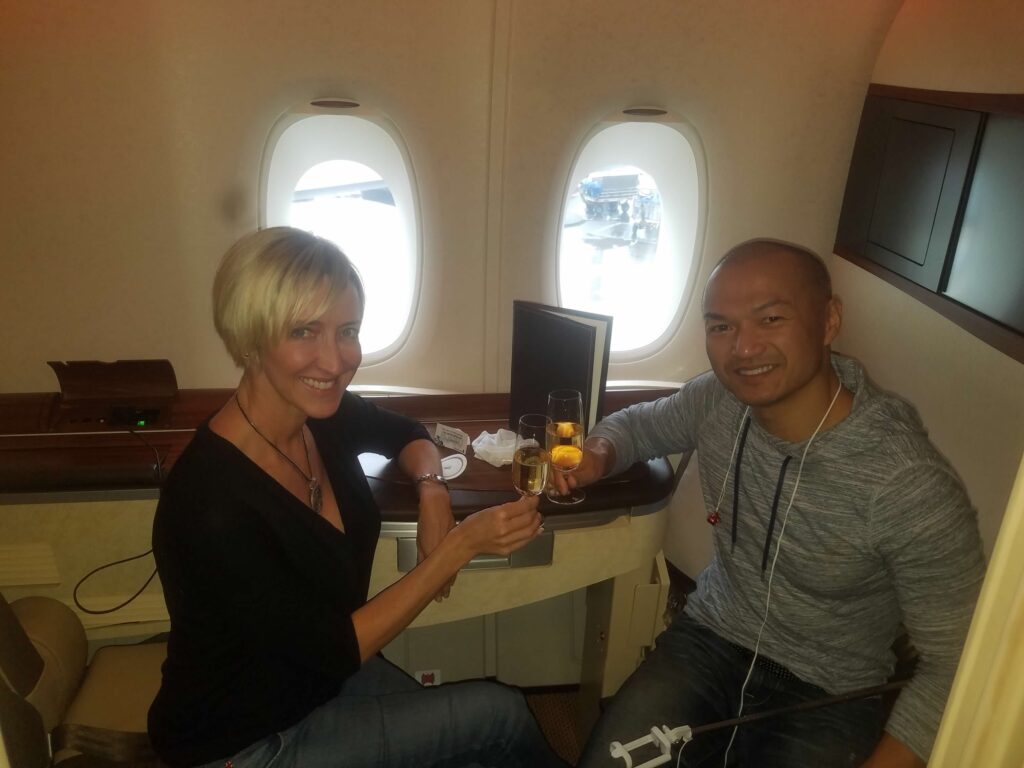
We took the subway to JFK, where our boarding pass gave us access to the Virgin Atlantic lounge. They had a decent selection of hot food and premium drinks. When it was time to board, we were funneled down a dedicated jetway, so that we could enter through the front of the massive, double-decker A380. Beautiful flight attendants dressed in traditional uniforms of sarongs known as Kebaya greeted us by name. The kebaya have beautiful batik designs and accentuate the trim physiques of the “Singapore Girls.” The male flight attendants wear tailored suits, and both have minimum height requirements.
We were led to our seats, which were individual suites with doors, offering near complete privacy. The seats were spacious, with footrests and large screen TVs. On the seat were noise-canceling headphones for use during the flight, and an amenity kit. In that kit were Givenchy pajamas, socks, slippers, an eye mask, earplugs, and Salvatore Ferragamo perfume/cologne, lip balm, and lotion. There were numerous cubbies for storage, one of which contained water and soft drinks.
Flights
We stowed our carryons and settled in, then had a choice between Dom Perignon and Krug champagne. What a choice! I chose one and Vuong chose the other. We both slightly preferred the Dom, but both were divine! Before departure, our champagne was accompanied by warm nuts. After takeoff, it was caviar with accompaniments including onion, chopped boiled egg, green onions, and crostini. This is how the other half lives!
The flight attendants set up my suite so that Vuong and I could have dinner together in our pajamas. They laid out a white tablecloth on my oversized tray table, placed cloth napkins and real silverware, and brought us warm towels. We enjoyed a multi-course meal with accompanying wine and conversation.
After dinner, Vuong went back to his suite. The flight attendants reconfigured our seats into lie-flat beds and dressed them with linens and a luxurious comforter. Then Amanda, my flight attendant, tucked me in and fastened my seatbelt around me! I fell asleep while watching a movie, and woke up about 45 minutes before landing for breakfast.
We had a short layover in Frankfurt and were continuing on in the same plane. We left our carryons and were personally escorted to the Lufthansa lounge (there was no Singapore Airlines lounge at this airport). After a few light snacks and conversation with a Portuguese death metal band called Moonspell, we were escorted back to our plane and continued on to Singapore. At Changi Airport in Singapore, we enjoyed the best fish curry we had ever had in their business class lounge. This airport is a destination in itself, with every type of shop and restaurant you can think of, an orchid garden, and a huge waterfall. There are hotels in the airport, as well as a movie theater. We showered at the lounge and had dim sum for breakfast.
Then, it was off to Hanoi! This plane was a 777 and did not have first class, so we had to fly business class… poor us! It was still a great experience, with huge, luxurious seats and fine cuisine. I got a nice nap!
Good Morning, Vietnam! Discovering Southeast Asia!
We felt the humidity as we disembarked the plane, although it was not too hot. The visa process was a bit of a debacle and took about an hour and a half. At the time, visas on arrival were available but required a pre-approval letter. We were kicking ourselves for not getting e-visas ahead of time.
We found our guide after passing through immigration. We loaded into our van and headed off into chaos. The sky was a bit gloomy and gray, and there was a lot of debris along the roadway from the airport. Beat up palm trees and shanty huts lined the street, and there was a smoggy mist in the air. Horns blared madly and cars edged in where there was no space for them to do so. Cars and scooters drove every which way, without apparent rhyme or reason. We crossed a very modern bridge over the Red River into Hanoi.
Dilapidated high rises alternated with charming, narrow 3-4 story houses with balconies and planters filled with colorful blooms. Scooters scooted about frantically, with most riders wearing helmets. Some of these helmets had holes for pony tails to stick out of! Most people wore helmets to protect their wallets, not their heads- if you weren’t wearing them, you would get stopped by cops demanding bribes.
Despite the lack of order to the traffic flow, we didn’t see any accidents. Electric wires hung in bundles, like some modern vine coursing through the city. Vuong conversed in Vietnamese with our guide and our driver, as I gawked at the scenes passing us by.
Hanoi
First Impressions
We arrived at our hotel in the Old Quarter, La Siesta, where we were greeted with cool towels and passionfruit juice. The lobby was trendy and decorated with dark woods and lush green plants. Our room contained a king-sized bed outfitted in crisp white linens, adorned with orchid blossoms and a little scroll with a welcome message. A beautiful lantern hung above the bed, and a basket of fresh fruit was on the dresser.
We dropped off our stuff and headed out to explore. Hanoi is really old. They celebrated their 1000th anniversary in 2010. The city is a juxtaposition of old and new, with historical buildings, ramshackle high rises, and shiny new buildings often populating the same block. There are old mom and pop food stalls as well as KFCs, Burger Kings, and Pizza Huts. From locals in conical hats peddling fruit, to grungy dreadlocked backpackers hostel hunting, we saw a great variety of people. Locals and tourists alike squatted on tiny, elementary school-like chairs and tucked into bowls of pho. Old Vietnamese men sat on the corner smoking cigarettes and drinking Vietnamese iced coffee.
Crossing the street is a harrowing experience. The key is to just… walk. Steady pace, don’t run or stop. Our guide told us to close our eyes and go, but I didn’t have the nerve to do that! The vehicles flow around you like a school of fish. As long as your pace is constant, they can predict where you will be and avoid you. Whew.
The Lake of the Restored Sword
Smells of cooking meat, incense, and exhaust assaulted our senses. It was still daylight, but the night market was already in full swing. In the center of Hanoi is Hoan Kiem Lake, the “Lake of the Restored Sword.” As the story goes, Emperor Le Loi was given a sword from heaven, which he used in battle. Then he returned it to the lake, where the Turtle King came and took it to the bottom of the lake. The lake is green in color, which is unique among lakes in Vietnam, and is home to several large turtles. In the center of the lake is a pagoda, reached by a pretty red bridge.
The lake is the center of town and a hub of activity. Kids chased dogs and played hacky sack as adults chatted and sipped beer (Bia). We grabbed some banh mi (Vietnamese sandwiches) and watched an old lady set up her food stall. The aroma of her grilling meat got to us, so we had a couple of skewers and they were yummy!
We had $10 massages and got lost on our way back to the hotel. We caught a cyclo taxi and were treated to a crazy ride back to our hotel. Exhausted, we slept until breakfast was almost over.
Food Tour
Our guide collected us the next morning for a food tour of Hanoi. We learned about the police structure over breakfast pho. Different color shirts mean different things, and the Communist party broadcasts messages of how great life is over loudspeakers every morning, just so citizens don’t forget… Our second dish was Bun Cha, or pork meatballs. These little meatballs were squished in cages and grilled, then served over vermicelli noodles. This specialty of Hanoi was delectable!
We watched two ladies make rice flour crepes, Banh Cuon, by spreading rice flour over a membrane stretched over a pot of boiling water. the crepes are steamed, scraped off, and filled with delicious toppings such as meat, peppers, mushrooms, and fish sauce. We discussed healthcare while snacking, and our guide informed us that, basically, everyone gets free healthcare. But if you have money, you can get private healthcare, which is way better. You can pay your way to the front of the line…
Different streets in the city tend to have different sorts of wares- for example, one road had only stalls selling fabric, while another had flowers, and another house goods. The streets were typically named after the goods sold there. You might see “Shoe Street” or “Silver Street.” The houses I mentioned earlier are called “tube houses” and are very deep rather than wide, as taxes were charged based on street front footage. Our guide also mentioned that the Vietnamese people typically didn’t care so much about accommodations, instead focusing on activities and appearances.
Dessert on “Silk Street” was Hoa Qua Dam, or Vietnamese fruit salad. This delicious concoction consisted of fresh fruit covered in ice, with a blend of coconut cream, yogurt, and condensed milk drizzled over the top. We finished with egg coffee, which tasted like a very creamy, rich, very foamy latte.
Temple of Literature
The Temple of Literature is a massive complex of temples, pagodas, and courtyards originally built in 1070 to honor Confucius, and reconstructed many times since. In 1076, the Imperial Academy, the first national university of Vietnam, was built on its grounds to educate the rich and powerful. After passing through the gates to enter the temple complex, you see three pathways- the middle is meant only for monarchs (of course, that is the one we chose to walk down), the left for administrative Mandarins, and the right for military Mandarins.
Mandarins were important bureaucrats in Chinese and Vietnamese government who were highly educated and powerful. They learned and taught here.
After passing through a series of five beautifully landscaped courtyards and encountering a wedding party, we reached the University. Surrounding the fifth courtyard, it felt like the climax of the complex. Large rooms filled with shrines and altars adorned with gaudy red and gold decorations contained offerings left to honor Confucius and Ho Chi Minh. Bonsai trees were scattered about, many of which had tiny little figurines arranged in depictions pastoral scenes capturing the country life of early Vietnam. There were pagodas with drums, bells, and gongs.
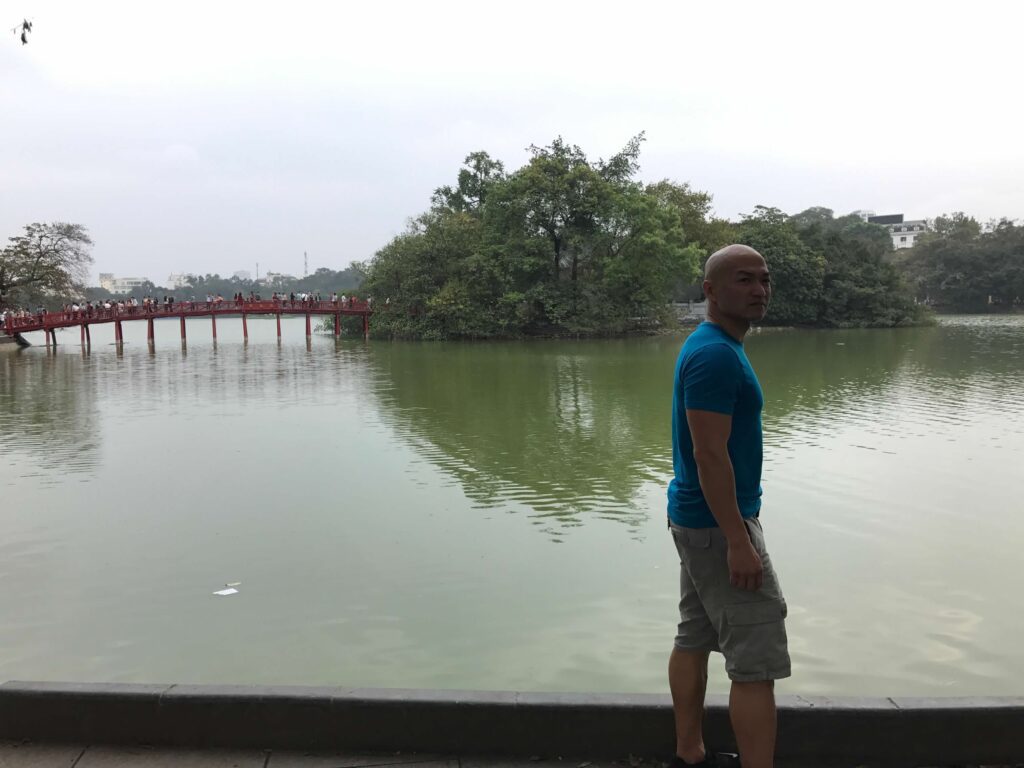
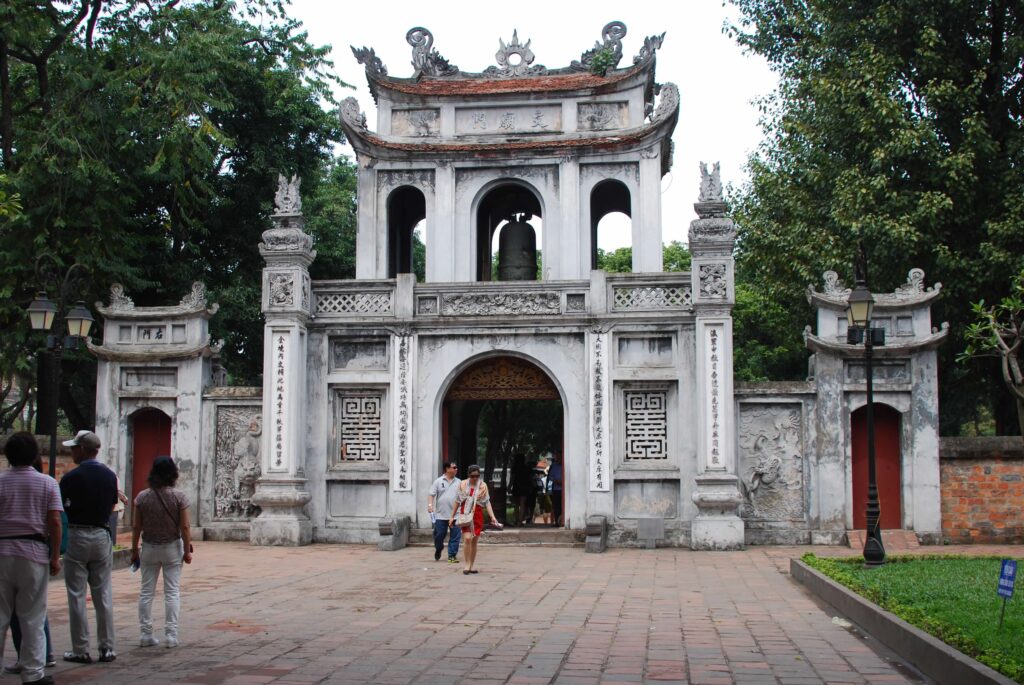
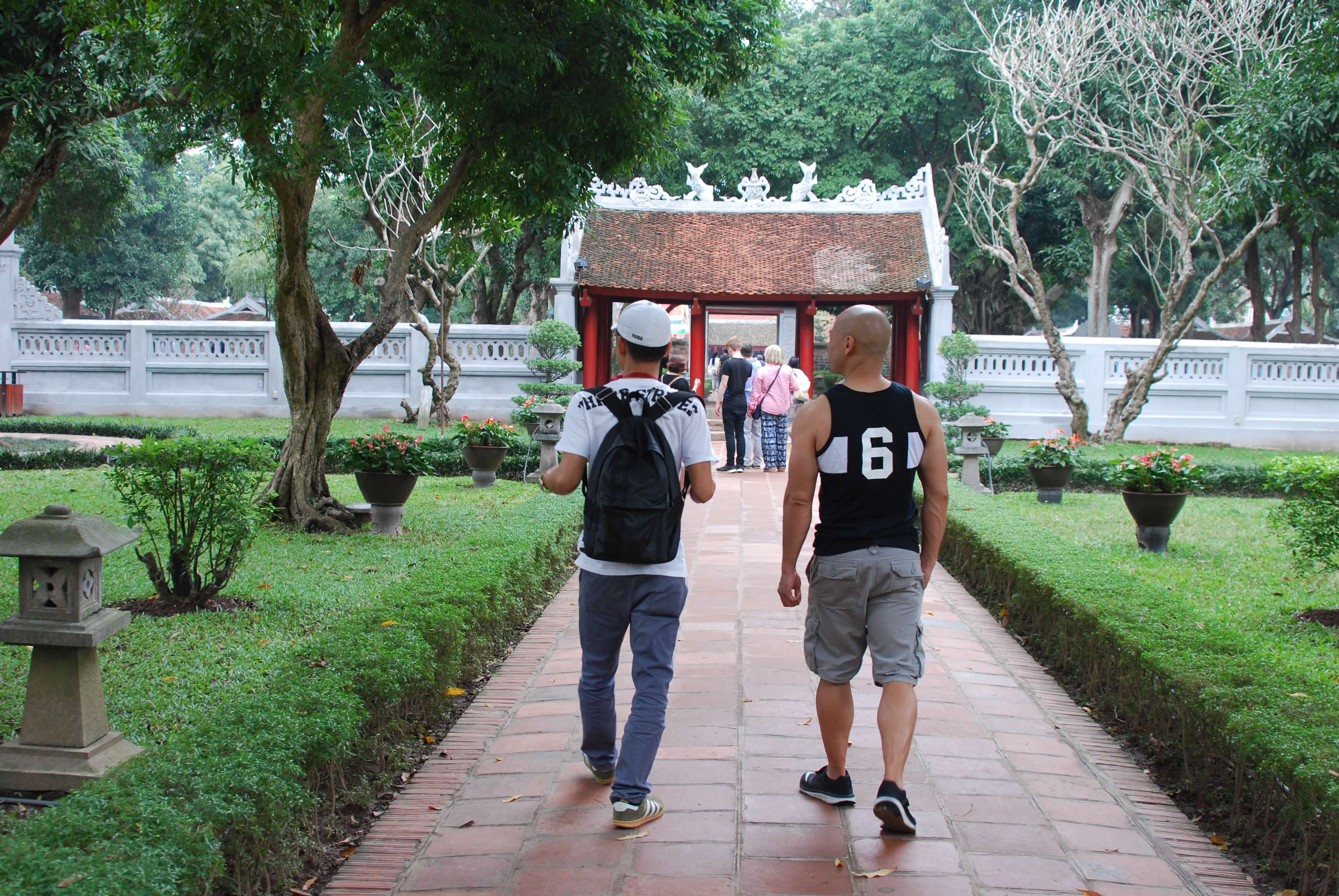
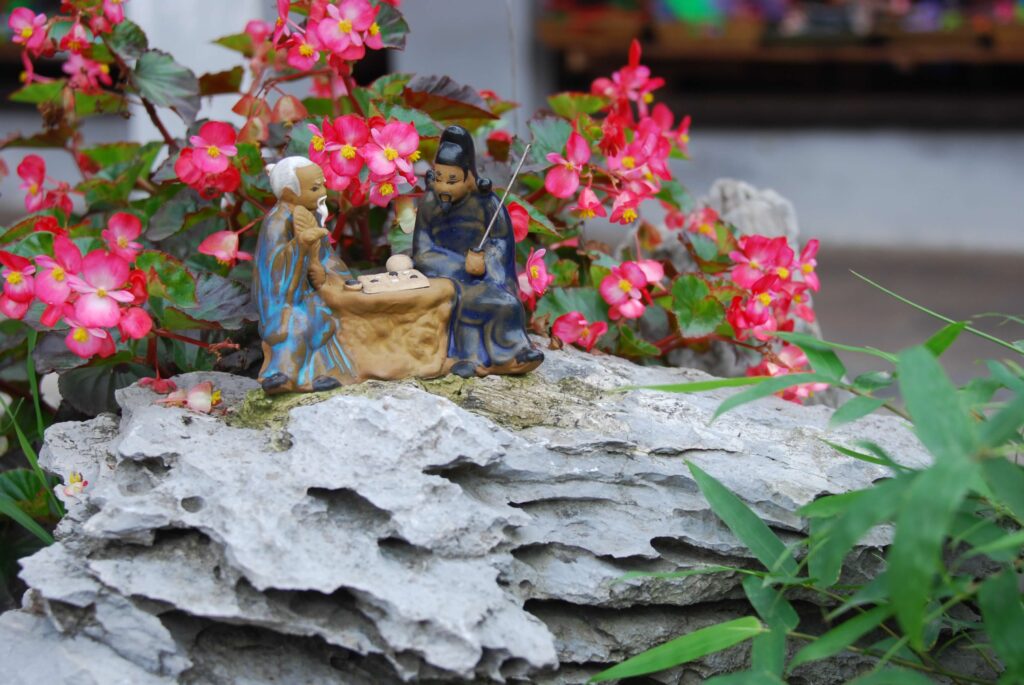
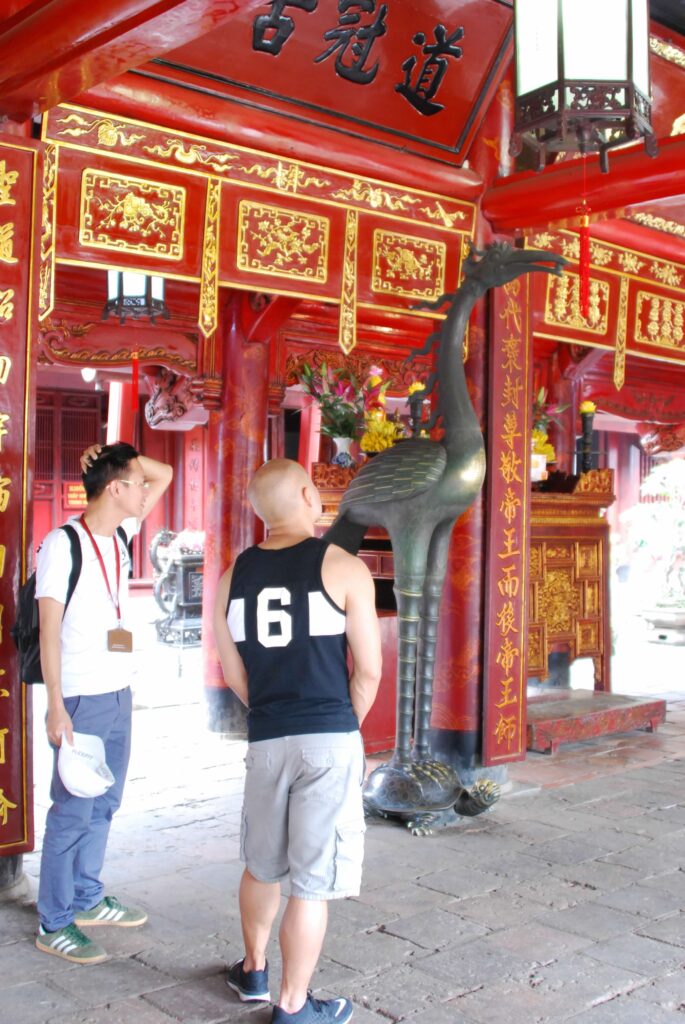
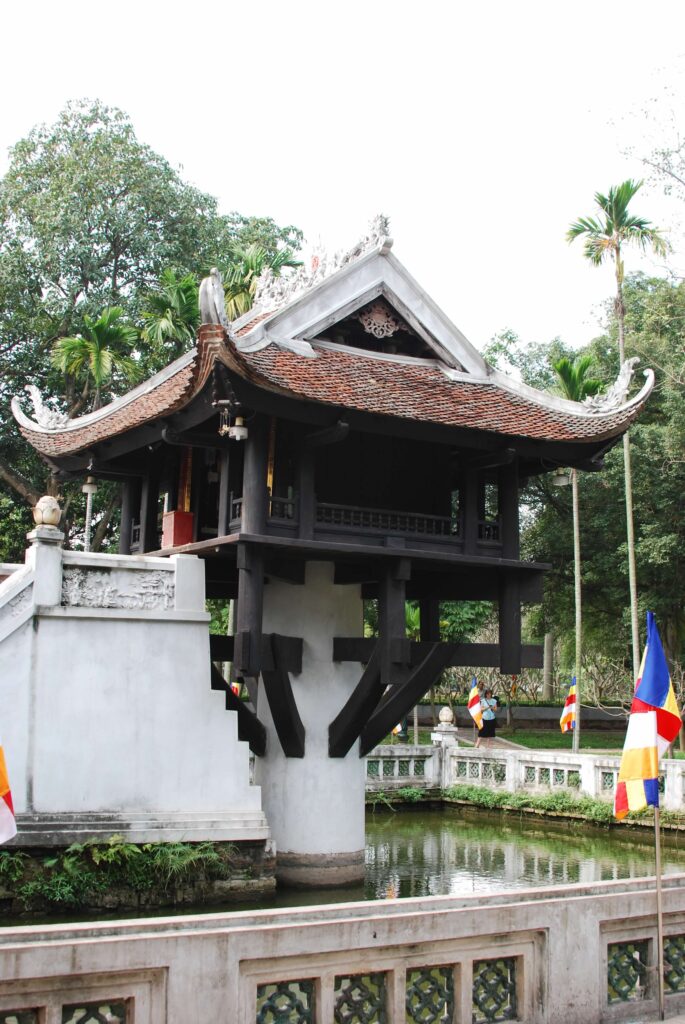
Mausoleum of Ho Chi Minh
Then we were off to Ba Dinh Square to see the supposed resting place of Ho Chi Minh. Apologies if I get any of this wrong- opinions surrounding HCM are varied and strong, and mine is not sophisticated or relevant. I am just going to tell it as told by our guide and, if you have opinions to share, please comment! His role in the history of Vietnam and the Vietnam war is complicated and inspires great emotion, and it is not something I want to address right now.
It is generally accepted that the body of HCM lies in this elaborate building fashioned after the tomb of Lenin; however, our guide doesn’t buy it. According to him, HCM’s philosophies would not have allowed for him to be laid in such a place. He was a simple man who did not want glory for himself. Instead, we wanted to be cremated and his ashes scattered all over Vietnam. But alas, the government knows best and erected a massive monument in this square where he used to hold court over rallies.
When we visited, the museum and mausoleum were closed, but touring the grounds was good enough. I have seen enough dead bodies in my day and, according to our guide, this one is not even real… who knows? Anyway, it is a grand, beautiful monument surrounded by manicured grounds and guarded 24/7, with the “changing of the guard” every hour.
The mausoleum and its grounds are adjacent to the presidential palace. The palace was initially constructed for Ho, but he thought it was just too much and lived, instead, in a small house in its backyard.
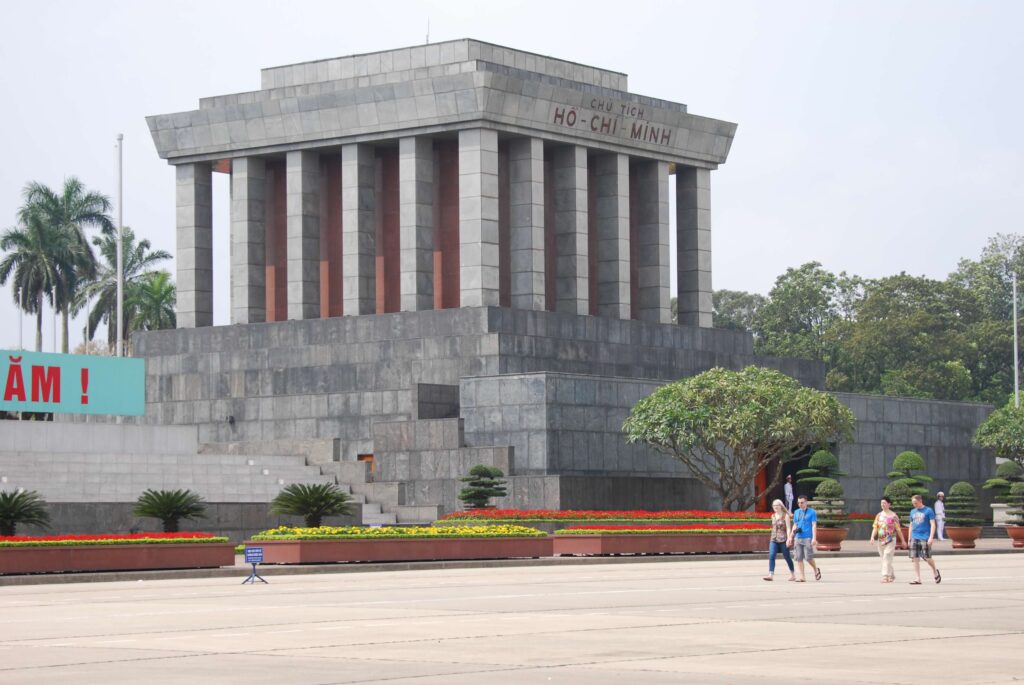
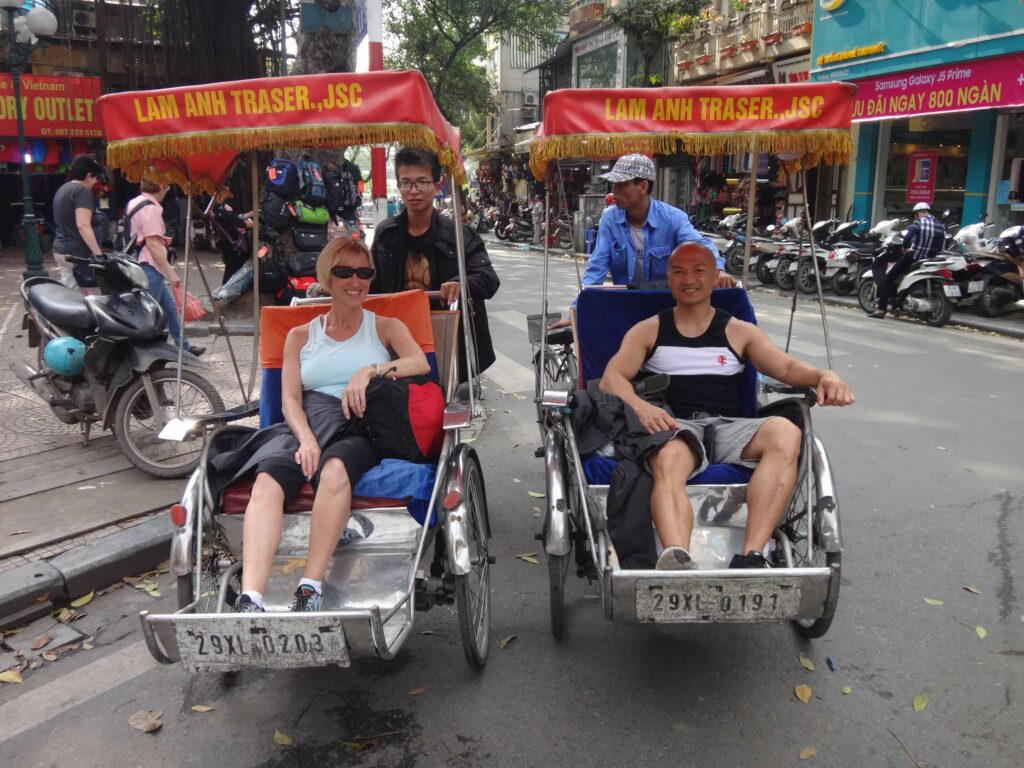
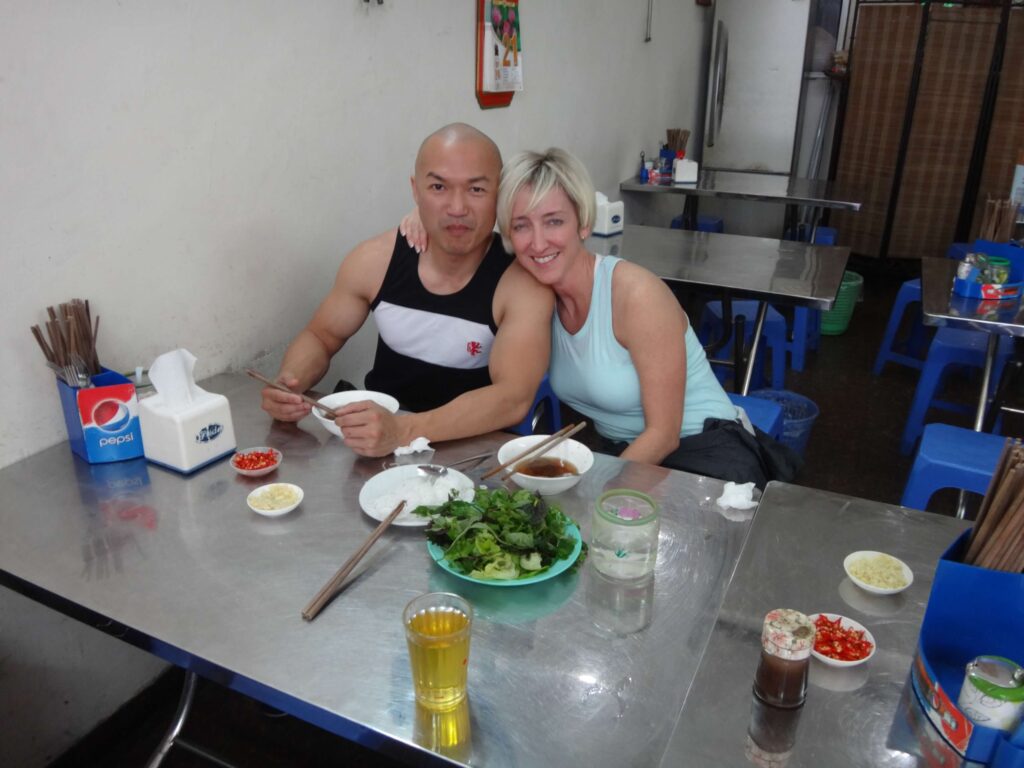
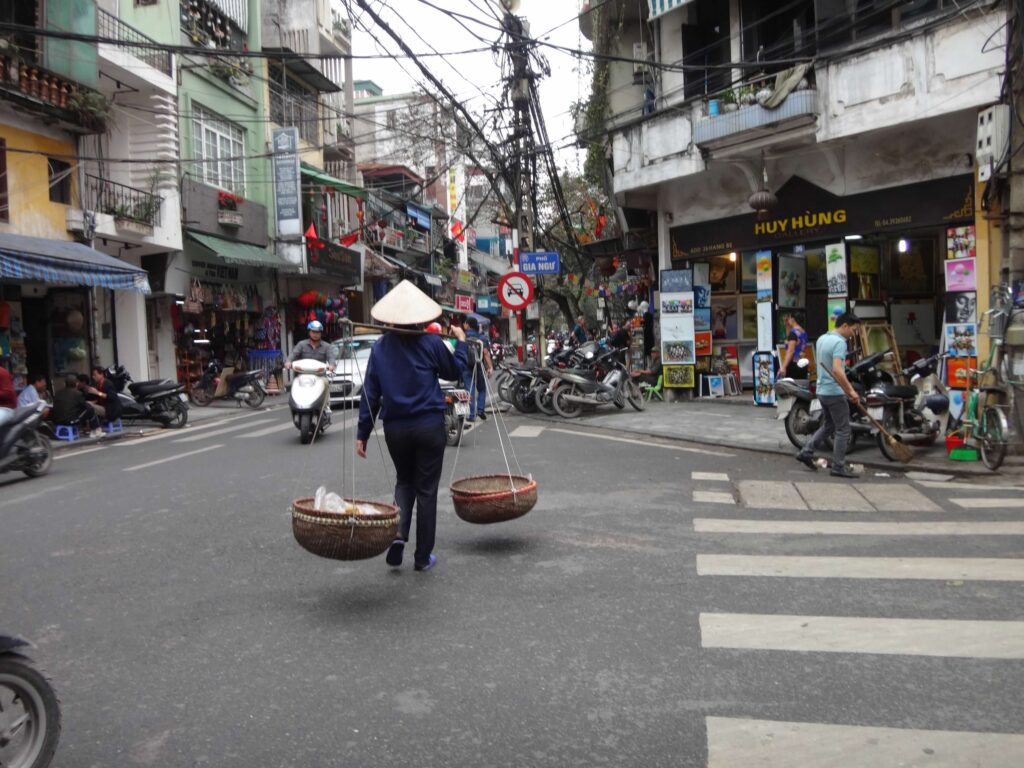
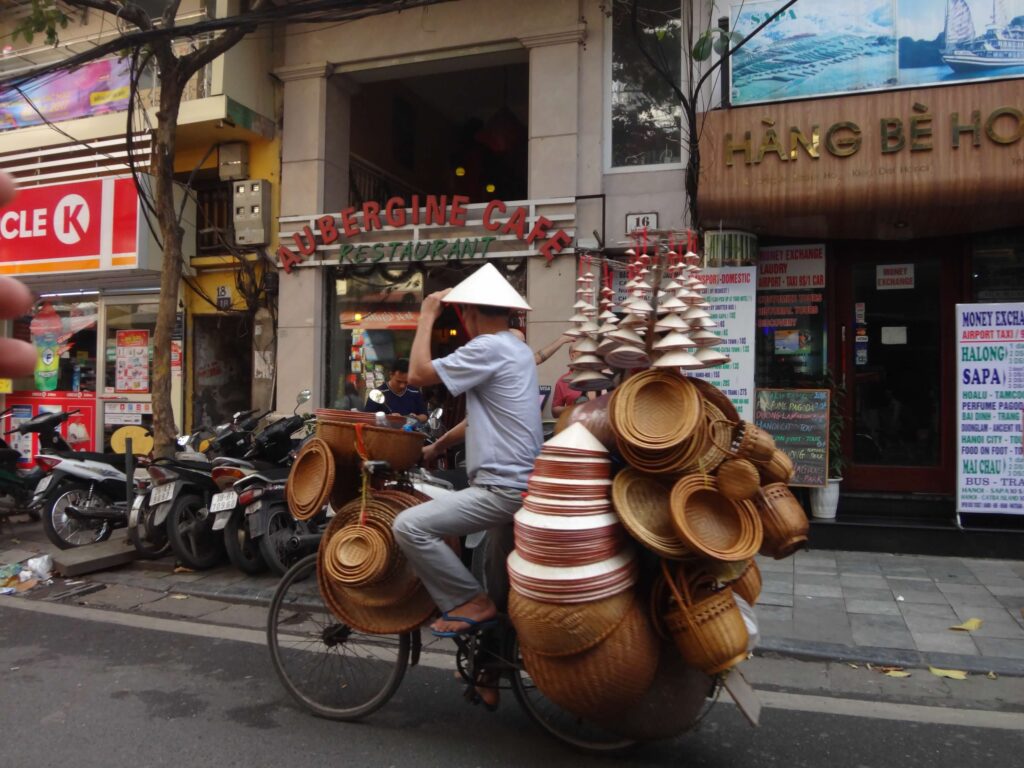
One-Pillared Pagoda
Also on the grounds of the mausoleum is the iconic One-Pillared Pagoda. This small structure has a sweet story – the Emperor Ly Thai Tong was childless and had a dream that a goddess brought him a baby on a lotus blossom. Shortly thereafter, he met a servant girl who gave him a son. He built this pagoda in the shape of a lotus flower to give thanks to that goddess for his child.
Cyclo Ride from Hell and Water Puppets
After a nice food tour and cultural introduction to the city, our day began to deteriorate. We were scheduled for a cyclo tour and were looking forward to it, after our harrowing ride back the the hotel the night before. We thought we were surely in for an adventure! Alas, it was not to be. Cyclos are bicycle taxis with a covered double seat in front. During the French occupation of Vietnam, cycles were luxury transport for the rich. Now, with the motorized vehicle traffic, things are different.
Our drivers spoke no English and pedaled very slowly. While we appreciated the caution, this resulted in us sitting in traffic, sucking in exhaust fumes, as we learned nothing. They deposited us at the Thang Long Water Puppet Theatre. Now, water puppetry is a longstanding form of performance art that requires skill and craftsmanship. The center of the stage contains a large pool of water, whose surface is the stage. The puppets are attached to a long bamboo rod (under the water) and operated by puppeteers who hang out behind a bamboo screen decorated to look like the facade of a temple. A band playing traditional Vietnamese instruments sits on one side of the stage. The puppets act out scenes of Vietnamese folklore and history.
I am not belittling this cultural art form, but our experience was mediocre. The performers and puppets were amazing, but we had had a long day and were tired. We were funneled into a musty theatre with 200 other Western tourists in their Hawaiian shirts and sneakers. I get that everyone wants to have cultural experiences, but this felt cheesy and inauthentic.
After sneaking out early, we circumnavigated the lake to check out the night market and bustling city life. We met a sweet boy who wanted to practice his English with me, so we strolled and chatted with him for a while. We watched little old ladies doing Tai Chi by the lake, and strapping young men working out on the outdoor gym equipment in the same area.
Dinner was arranged by our tour operator and was a touristy fail. The restaurant was full of tourists and the menu was less than authentic. The food was good, but we prefer to eat what the locals eat.
Sa Pa
After dinner, it was off to the train station, where we boarded the overnight train to Sa Pa, a quaint town in the Vietnamese highlands. The train was like something out of a movie, with lacquered rich, dark wood doors and accents. Our cabin had two beds and a center table, and was right next to the shared bathroom. We changed into our “dystopian future pajamas” (from the flight), as Vuong calls them, and hit the sack. The herky-jerky movements of the train woke us periodically, and then we finally enjoyed a breakfast of croissants and coffee while looking out of the window as we approached the Cai Lao train station.
An hour’s drive through mountain passes rewarded us with peekaboo views of rice terraces shrouded in mist. The mysterious atmosphere was surreal, and we gazed out of the windows in awe.
Sa Pa is a quaint, mountain town, alright. But it is bustling and filled with scooters and buildings with red and yellow signage. We were shuttled to the top of the hill to the Victoria Sa Pa Resort. This place was stunning. We had upgraded to a suite, which had a bedroom, living area, humongous bathroom, and spacious balcony with panoramic views of the village and the mountains. Our canopied, four-poster, mahogany bed was surrounded by mosquito netting, which I just love. It adds such a luxurious, romantic feel to any bed. I am thinking of getting some for our home…
We arrived in time for a breakfast of Banh Xeo, Vietnamese crepes. My favorite! We then had brutal, abusive massages at a massage parlor just outside of the resort entrance.
Cat Cat Village and the Hmong
Our guide took us to a Hmong settlement a little higher in the mountains. It was raining which, again, added to the charm and mystery of the place. We started at the top of the village and made our way down stone stairs lined by merchant stalls, as our guide taught us about their culture. Groups of pigs rooted around underfoot, and groups of children ran around doing what kids do. At the bottom of the hill, a bridge over a river with a stunning waterfall led us to a performance hall.
Now, Cat Cat Village is truly a Hmong settlement, but they do capitalize on tourism a bit. This adds a somewhat artificial feel to things, but still allowed us to learn and get a feel for their lives. In the performance hall, we watched a Hmong dance performance in which they demonstrated their courtship rituals. When a man is interested in a girl (usually she is around 15 years old), he and his friends kidnap her for 2-3 days. After this, he returns her to her family. If she enjoyed her time in captivity and agrees, the couple marries. If not, they have drinks and remain friends.
We took a different route back, taking time to seesaw and swing on some playground equipment on the side of the mountain.
Back in SaPa, we enjoyed an evening on our own. Thang Co is a specialty of the Hmong people in Sa Pa. This is meat stew which is typically made with horse meat, but can also be beef or pork. We found a restaurant called Nha Hang Kham Pha Viet. We walked in, and the music stopped. All eyes were on us- the blonde white girl and the Vietnamese muscle man. The host seated us right in the middle of the dining room, by the grill, for maximum viewing pleasure of the other patrons. Vuong was able to communicate with the waiter, and we enjoyed a delicious meal of salmon and beef. There was a buffet with horse meat, and we are adventurous eaters. BUT, this horse stew contained various organs and we just weren’t feeling it today.
After being accosted by a tiny girl carrying an even tinier baby, actually begging for money and tugging at our heartstrings, we found a cool coffee shop. We enjoyed our Ca Phe Sua Da while sitting on smooth, carved wood furniture.
As always happens, I became sick with some awful gastrointestinal ailment. While this put a damper on the next couple of days, I powered through. One particular day, we headed back to the Hmong areas to see another village. We passed backpacker hostels and homestays along winding roads. It was a sunny day, so we could see the peak of Fansipan, the highest peak in Southeast Asia, looming in the near distance. AKA the “Roof of Indochina,” the slopes of Fansipan were decorated with rice terraces and villages.
From the moment we stepped out of the vehicle, we were accosted by Black Hmong women in traditional garb. The Hmong are named for the dominant color of their dress, and these ladies wore indigo/black fabric with brightly colored embroidery, leg warmers, and headdresses. They walked with us, and despite their ulterior motives, I felt a kinship among these women of a different world. They talked to me about their lives, how they tell the time of year by the harvest rather that traditional calendars, and how they use herbal remedies when sick.
Of course, they were working. They needed to sell their purses, and we happily bought a few. But we took the time to try and connect, and were rewarded for it. Some rewarded us more than others… this ancient, edentulous woman took a liking to Vuong. She began to leer at him, then pinch him, and even smacked his butt a few times! He eventually snapped “Stop it, Grandma!” in Vietnamese, and she took the hint… she left him alone, but not before saying something very suggestive in her native tongue…
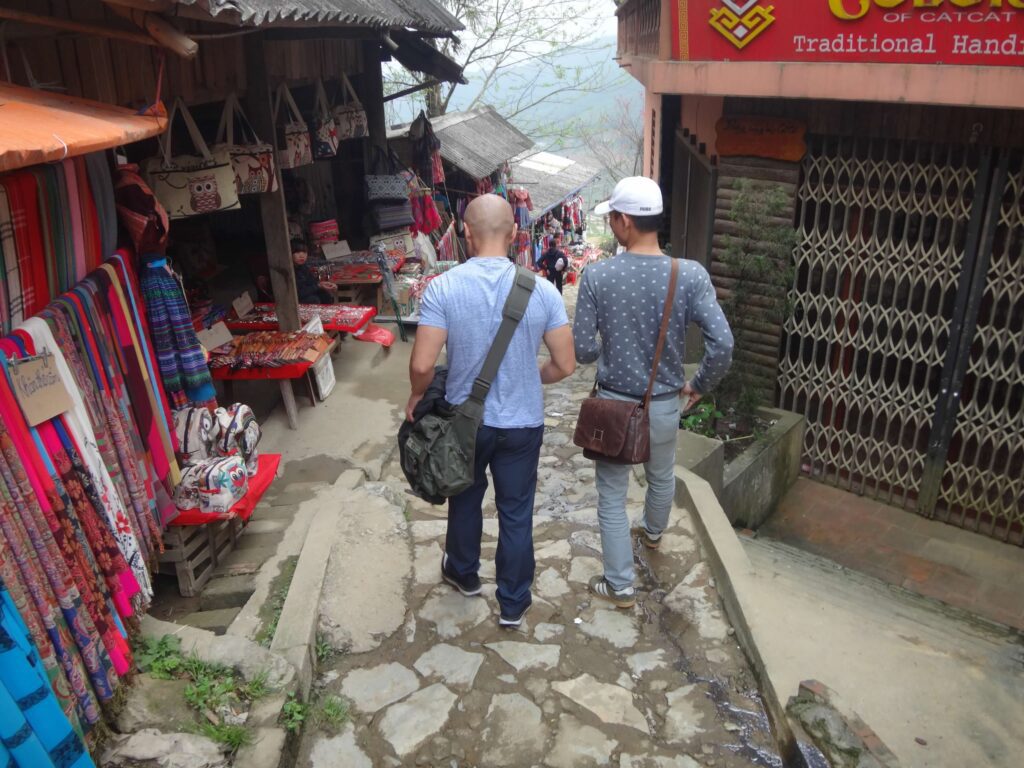
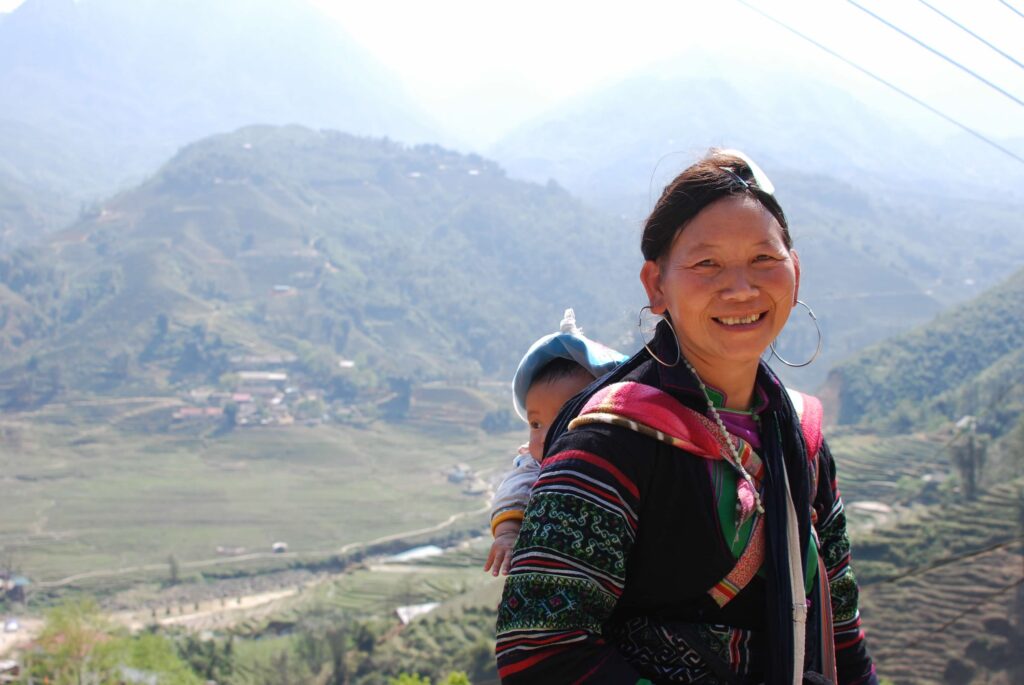
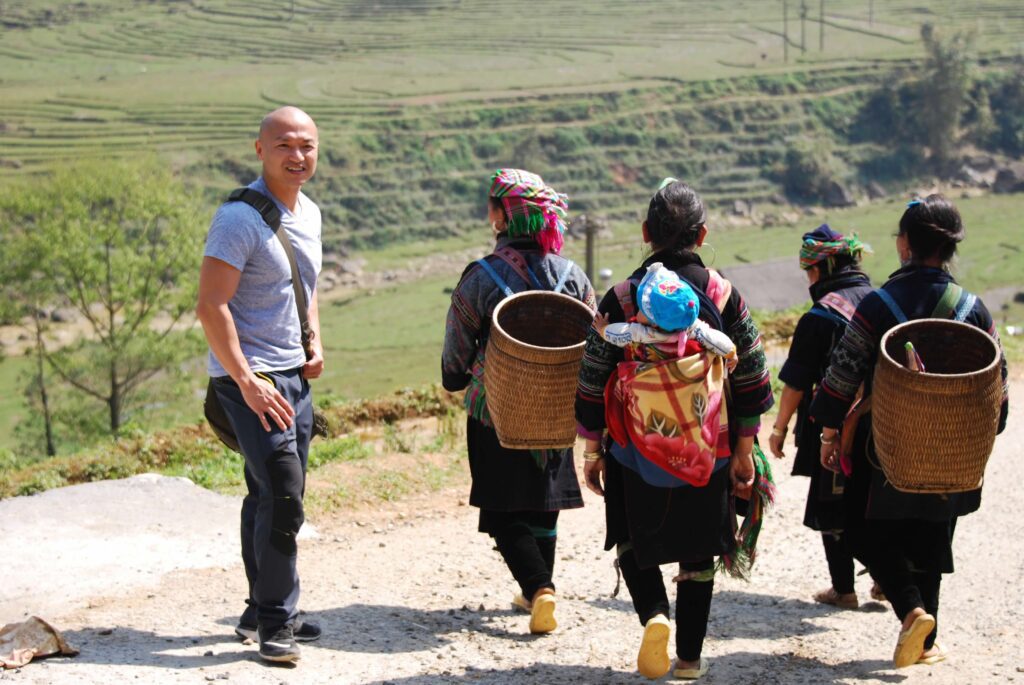
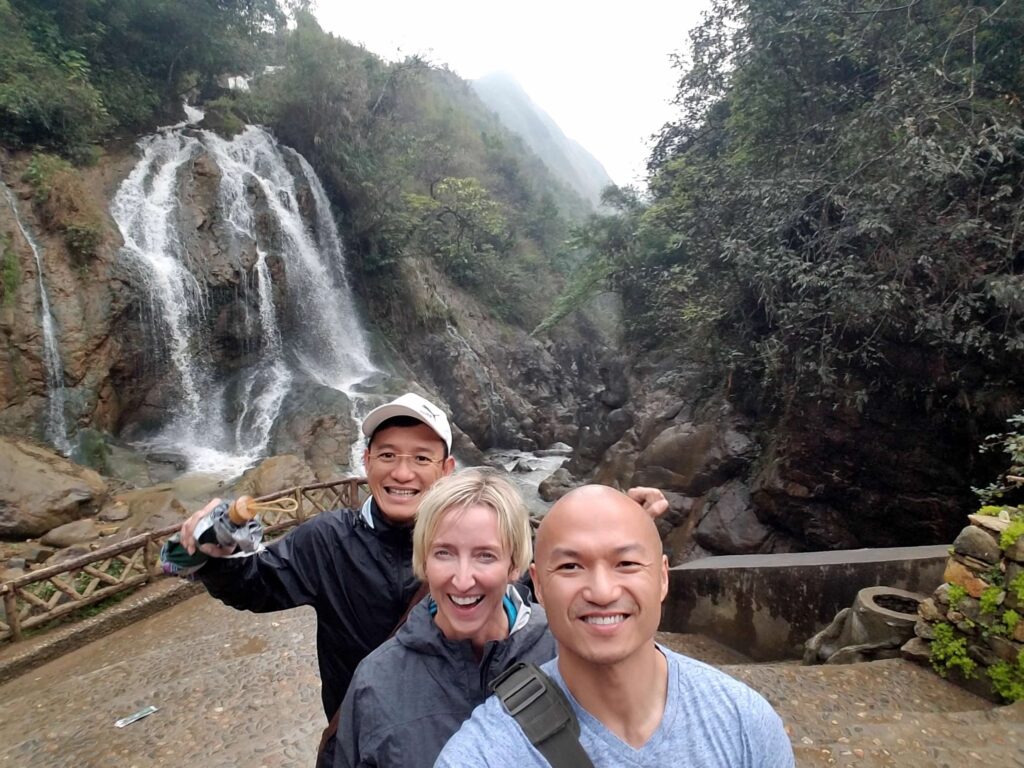
Ha Long Bay, The Bay of Descending Dragons
We took the overnight train back to Hanoi. Our hotel, La Siesta, had arranged for us to have a day room in which to freshen up. We were then off to Ha Long Bay! The 5 hour drive took us down pot-holed roads, through some traffic and some more remote areas.
We passed by dining establishments serving both dog and cat meat, Thit Cho and Thit Meo. I must say that this does not bother me in the least. You eat what you have. As long as pets aren’t being puppy-napped and the animals are treated humanely, I just don’t see the difference in eating dog, cat, or horse versus cow, sheep, or pig. I’d even eat rat, as long as it was a country rat and not a city rat, LOL.
Signature Royal, Ha Long Bay
Our cruise director met us at the terminal and escorted us to a tender boat which took us out to our wooden junk for the night, the Signature Royal. This was an absolutely wonderful experience. The boat was immaculate and beautifully decorated. If you visit the website, you can see- the photos are accurate. The food was delectable and plentiful, and everything was included. We had the same table for each meal, and it was located on an enclosed patio with large windows. As we dined, we watched the limestone karsts go by.
A thick mist coated the seascape, and we felt like we were on another planet. Layers of the formations extended as far as the eye could see, dark greens fading into pale blues and grays. The limestone towers formed as a result of sea erosion millions of years ago, if you believe the scientists…
Legend, however, says that a mother dragon and her babies were sent to defeat invaders coming from the sea. After burning them to ash, giant emeralds appeared in the bay, which were actually the dragons’ teeth. These teeth eventually became the limestone formations present today. Legend also has it that the Vietnamese people descended from dragons.
On the top deck of the boat was an astroturf lawn with lounge chairs, where we relaxed and took in the serene atmosphere. It was surreal and peaceful despite numerous other boats littering the emerald green waters.
We visited a floating fishing village and a pearl farm. Kayaking in Ha Long Bay was an all-time travel highlight! We were able to get up close and personal with the karsts, paddling under arches and into nooks and crannies. Women in conical hats paddled some passengers, and added to the otherworldly atmosphere. We visited a cave, and spent a few minutes on a lovely beach on one of the islands.
A cooking class was available, but we skipped it and hung out on the roof with some friends we made, taking in the spectacular scenery. After a gourmet dinner, we fished off the boat, but didn’t catch. The next morning, I enjoyed coffee and journaling on our balcony, while Vuong attended a Tai Chi class on the top deck.
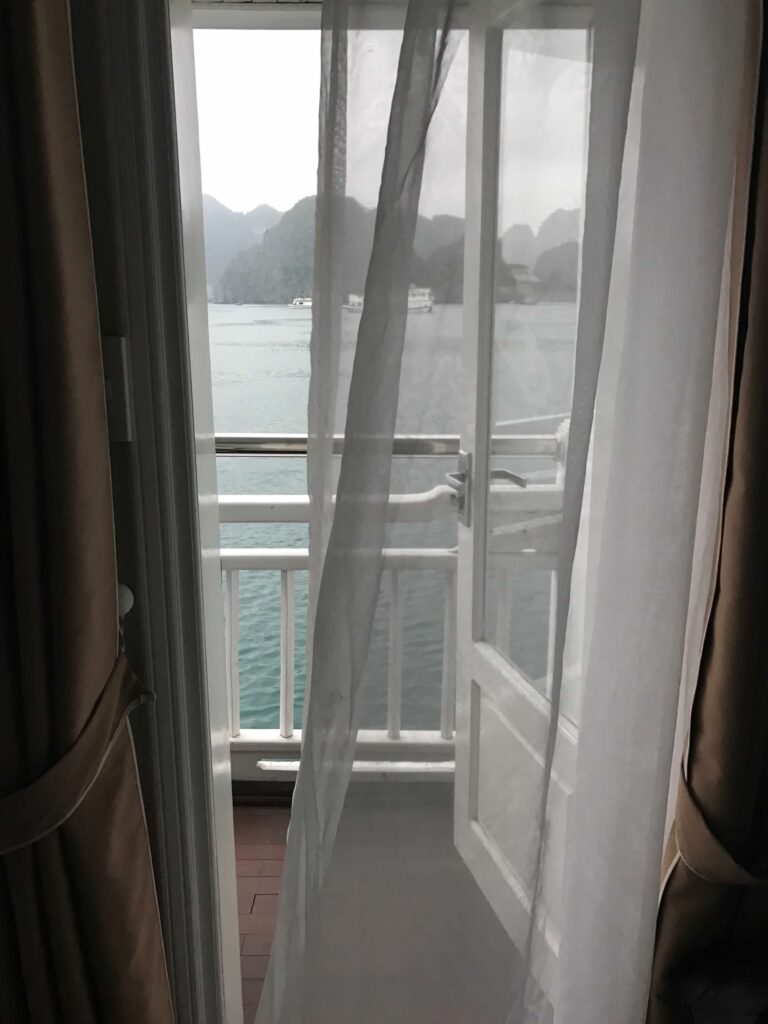
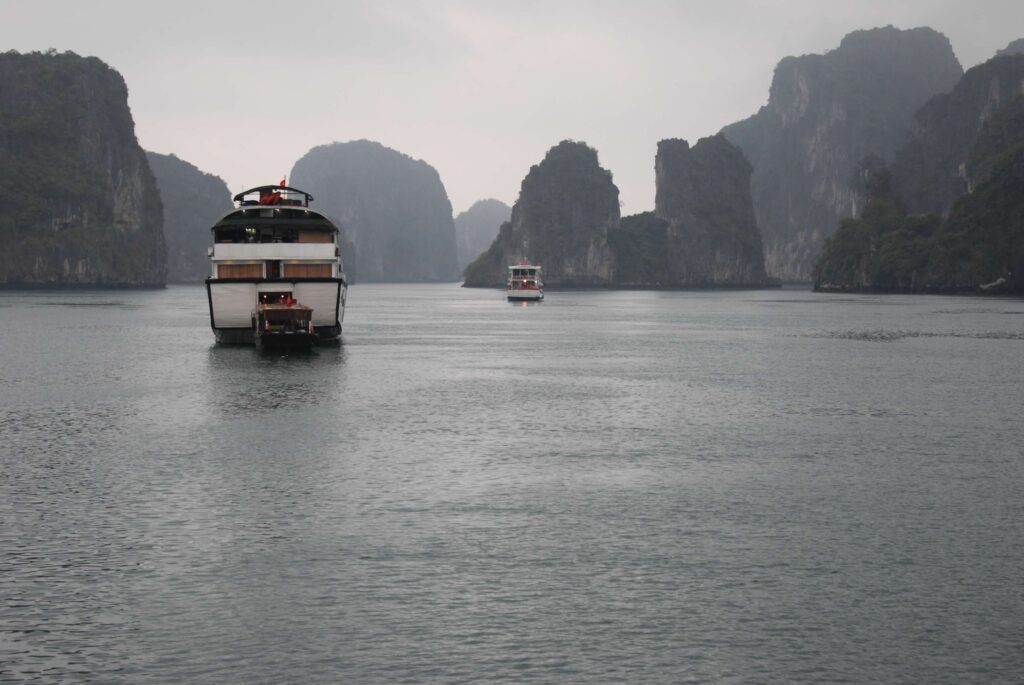
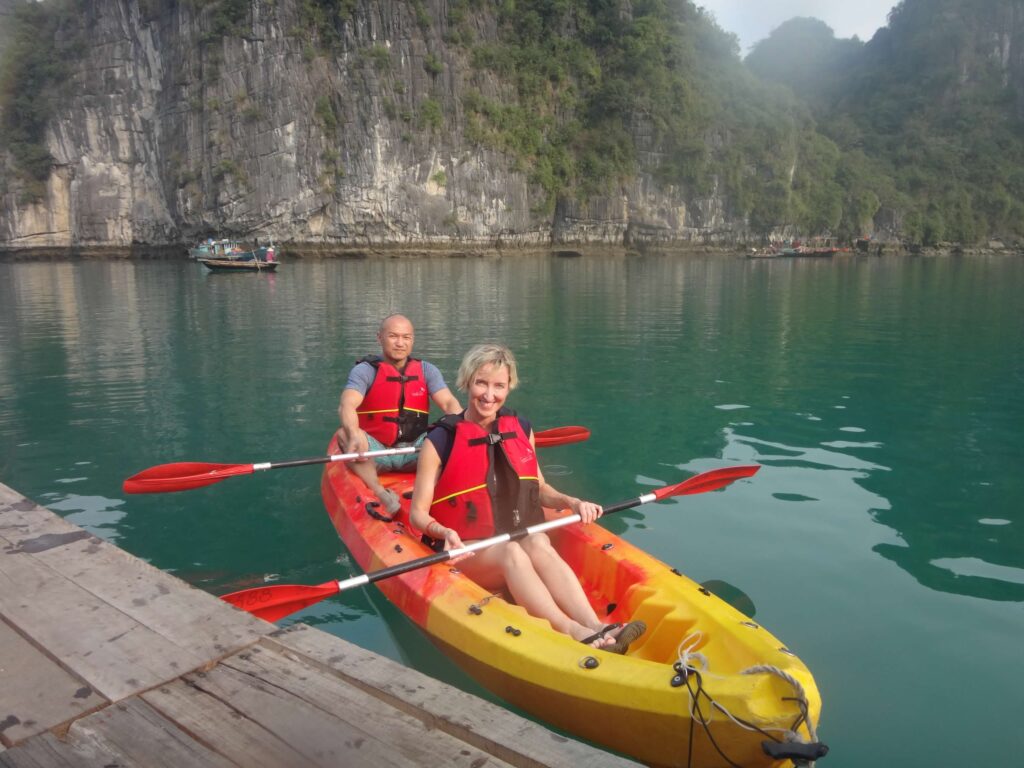
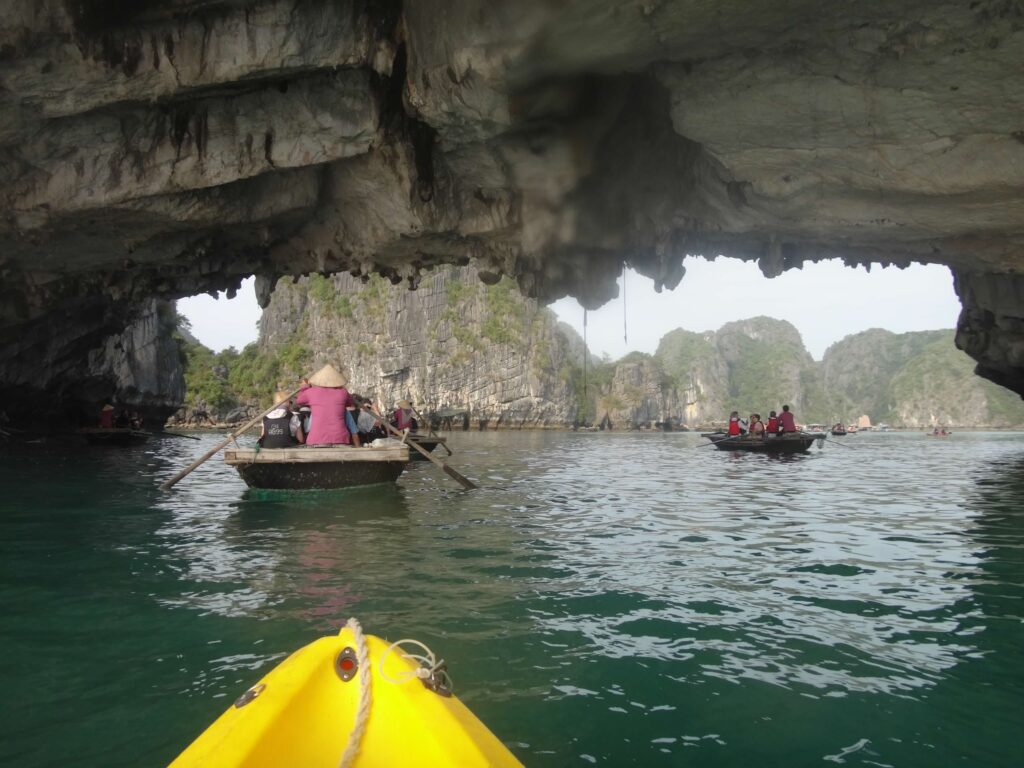
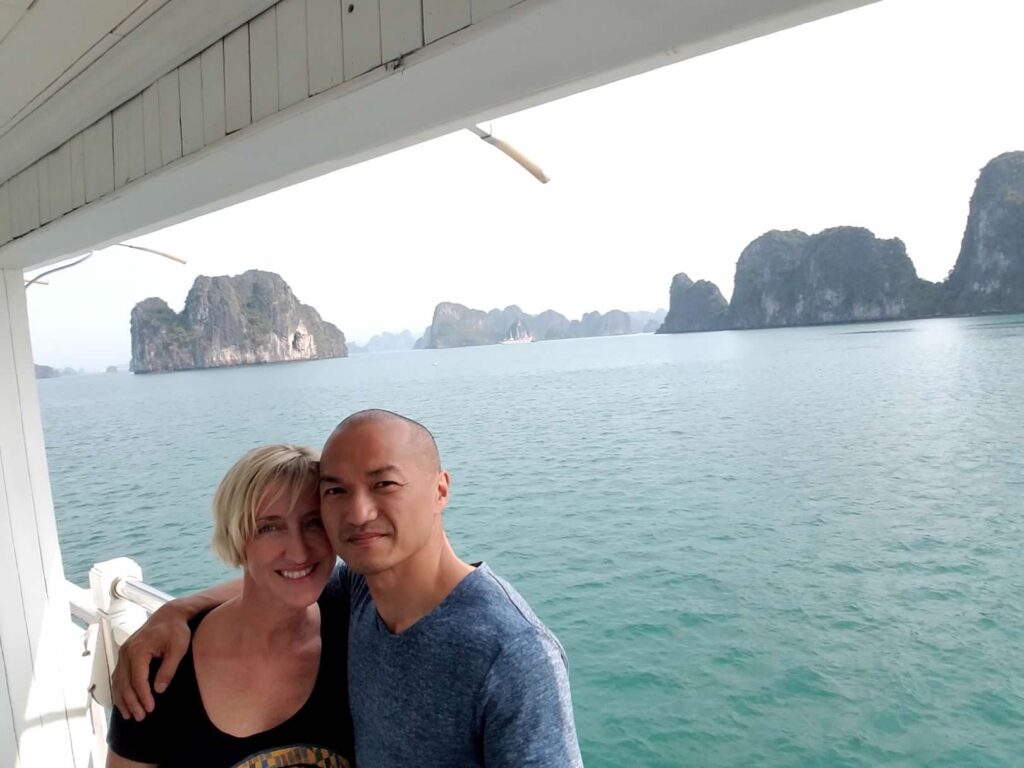
Back to Hanoi
We had a couple more days in Hanoi. We had massages at the hotel, and explored the Old Quarter and the area around the lake on our own. Highlights included an old man playing a nose flute (yes, he was playing a flute with his nose), chatting with some expats over Tiger beers, and Korean BBQ overlooking the insane streets of the city. We saw a large circle of people around a street performer, so we had to see what was going on- it was a fiddle player playing Cotton-Eyed Joe!
We had snacks in a gorgeous cafe filled with paper lanterns near our hotel, on a balcony looking out over the night market. Known as “Lantern Lounge,” it was a touristy but charming spot which appears to have closed down. Night markets are very common in Asian cities- in a park or on a blocked-off street, they are centers of activity and commerce and are a great way to get into a city and try some cheap street food. Several hostels were in this area, most of which were around $5 a night. A good meal of street food could be had for $2-3. We saw locals, college kids, and wizened backpackers who appeared to have been on the road for months.
The Hanoi Hilton
On our very last day, we visited Hoa La Prison, AKA the “Hanoi Hilton.” The French originally used this prison to detain Vietnamese political prisoners, and later the Vietnamese held American POWs here. Famously, John McCain was here for a period of time after his plane went down in a nearby lake. There were various torture devices, and the cells were tiny, bleak, and dark. Oddly, there were plastic mannequins representing prisoners.
History is written by the victors, and the Vietnamese people who created this museum talk about how well the American prisoners were treated, and there were photos of them playing basketball, caring for chickens, and getting medical care. I’m not buying it… Our visit was a strange and harrowing experience.
We visited the Tran Quoc pagoda, a Buddhist temple on the banks of West Lake, where John McCain’s B52 crashed. As our last act in Hanoi, we visited a sort of food court where we finally found Southern Vietnamese cuisine. Now, we enjoyed the food we had in Northern Vietnam, but it was not what we are used to. This was the best meal we had had!
Our flight from Hanoi to Bangkok was in business class on Qatar Airlines. They can definitely hang with Singapore Airlines! The seats and food were fantastic, and the seats vibrated! Check out my next post to read about our time in Bangkok and Koh Samui, Thailand, where we eat grasshoppers and hang out with cobras.

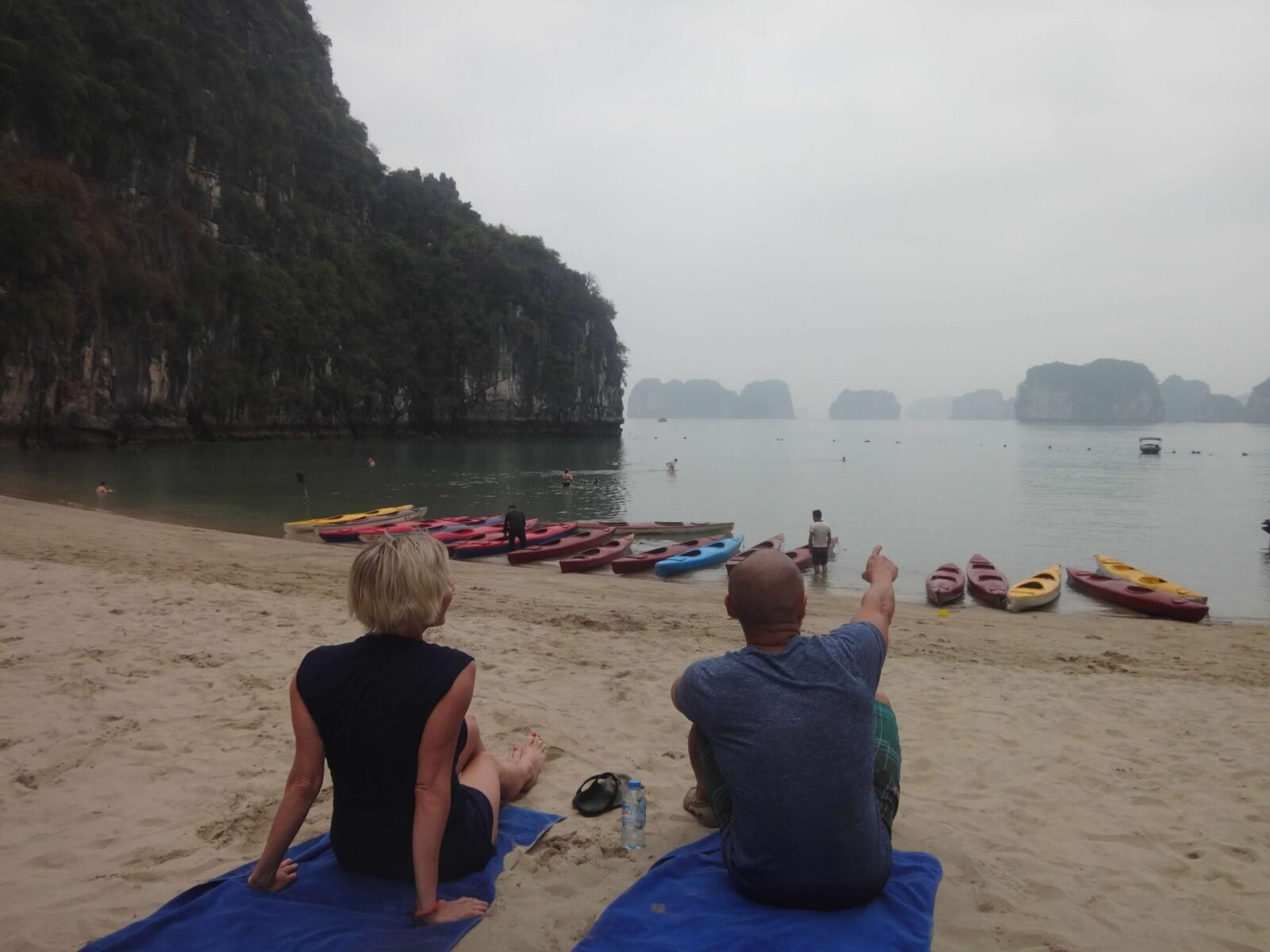
Jennifer,
I guess Vuong could still remember a lot of the places in Saigon? Is Vietnam still divided politically or is it pretty much a communist country in toto?
Jim Stratton
We didn’t make it to Saigon this time. We’ll be there in February, but he won’t remember. He was only 1 yr old when they escaped. Vietnam is united now and, while there is a strong capitalist culture, the communists are still in power.